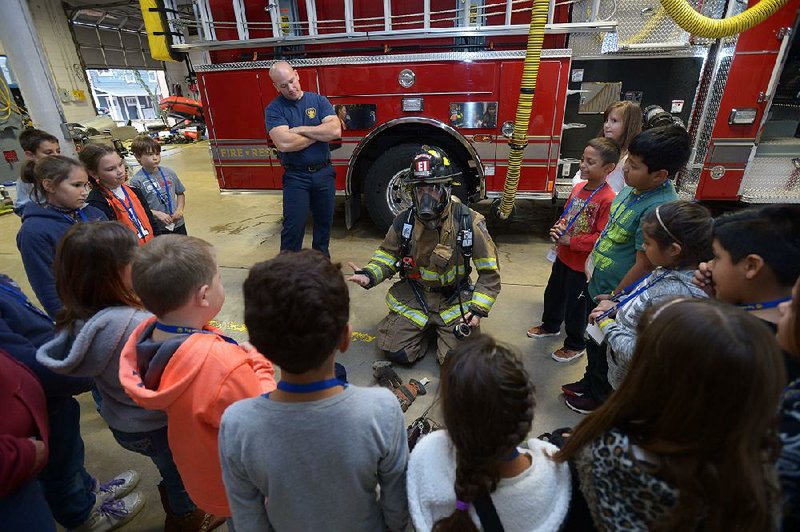FAYETTEVILLE -- The Fire Department earned the highest public protection classification, which could mean lower insurance rates for residents, officials said.
The rating comes from the Insurance Service Office, which analyzes public fire protection capabilities of departments throughout the U.S. through its Public Protection Classification Program.
Fayetteville insurance
Fayetteville residents can review or download the report for their insurance agency by www.fayetteville-ar… then following the tabs: Government > City Departments > Public Safety > Fire Department > Insurance Rating Information.
ISO ratings
To come up with the ratings, ISO evaluates three areas:
• 50 percent of the score looks at your local fire department, including staffing, training, geographic distribution of firehouses and adequacy of the fire equipment.
• 40 percent of the score takes into account the community’s water supply, including the placement and condition of fire hydrants and the amount of water that’s available to put out fires.
• 10 percent of the score measures the efficiency of emergency communications, such as the 911 system and the number of emergency dispatchers.
Source: ISO Public Protection Classification summary report
The program provides objective standards to help fire departments with planning and budgeting for facilities, equipment and training. Also, most insurance companies use ISO ratings to determine premiums for residential, commercial and industrial property.
"Most U.S. insurers -- including the largest ones -- use PPC information as part of their decision-making when deciding what business to write, coverage to offer or prices to charge," said Alex Shurbert, National Processing Center manager, in a letter to Mayor Lioneld Jordan.
The classifications go from 1 to 10. Class 1, which Fayetteville earned, generally represents superior property fire protection, and Class 10 indicates a fire suppression program does not meet ISO's minimum criteria, according to its website.
Historically, residential communities with the worst ISO ratings have had fire losses that were more than twice the amount of losses in communities with the best ratings, according to ISO studies.
A lower ISO class can save a homeowner an average of $200 per year, according to reports from other cities. However, it is up to each insurance agency what it will charge, and it is up to the property owner to research the quoted premiums from various agencies.
Only 241 communities countrywide had a Class 1 rating as of 2017, according to a Public Protection Classification summary report.
The Fayetteville Fire Department jumped from a Class 4 to a Class 2 rating in 2014.
Assistant Chief Thomas Good said the department has been working with the dispatch center, mapping division and water department to make the necessary changes to earn this rating.
The department added another ladder truck and a rescue engine company and three people to each shift to increase the chances a unit will be close by when the call comes. Dispatch upgraded the Computer Aided Dispatch system to recognize the closest unit and sends them to an emergency after 911 is called, he said.
"You are always getting the closest fire truck to your location, which helps response times," Good said. "One of the big factors is the water supply and our ability to deliver the needed amount of water. We worked to get accurate numbers with water department, and that helped push us over the edge. It's really been a cooperative effort."
The fire incident data the department gave to the ISO was very detailed, Fire Chief David Dayringer said. To summarize, the first unit to a structure fire arrived in 8 minutes and 36 seconds, 90 percent of the time in 2015. In 2017, the first unit arrived on the scene in 7 minutes and 25 seconds -- a 1 minute and 11 second improvement. The goal is to arrive in 6 minutes and 20 seconds, 90 percent of the time, he said.
Fayetteville joins Rogers and Springdale, which means about 240,000 residents in Northwest Arkansas are protected by ISO Class 1 fire departments.
"I want to thank our fire department and city employees who worked so hard to make this happen," Mayor Lioneld Jordan said in a news release. "Achieving a Class 1 rating benefits our community greatly with better public protection and providing the opportunity for people to save money."
Earning the rating doesn't mean there's not room for improvement. Fayetteville scored a 91.07 out of 105.50, according to the summary report.
More credits are available in categories such as Reserve Ladder Service, Deployment Analysis, Company Personnel and Training.
"We will address each category to see if we can pick up more credits," Dayringer said. "Such as keeping a ladder truck in the reserve fleet, and installing count-down clocks in each fire station so the firefighters can monitor how long it takes them to get on the truck."
Most importantly, he said, the city needs to maintain this classification and keep pace with the rapidly growing population.
Since 2014, the mayor and city council have authorized many improvements, such as replacing the aging fleet of fire trucks, approving grant funding for protective wildland gear and a state of the art live burn training tower and support building on top of adding the additional fire company and upgraded dispatch system.
"These moves have helped keep pace with the growing population and increased calls for service from the citizens," Dayringer said. "I'm sure they will continue to support the public safety infrastructure for our growing city."
NW News on 05/05/2018


